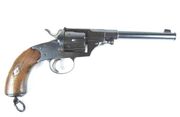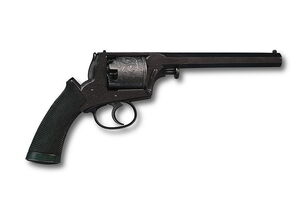(→Traditional Double Action: clean up) |
Tag: Visual edit |
||
| (9 intermediate revisions by 5 users not shown) | |||
| Line 1: | Line 1: | ||
| − | The '''action''' of a pistol is the mechanisms that |
+ | The '''action''' of a pistol is the mechanisms that take place when the trigger is pulled. |
==Single action== |
==Single action== |
||
| + | [[File:REVOLVERES_1_021_web.jpg|thumb|An [[Reichsrevolver|M1879 Reichsrevolver]], a single-action revolver.]] |
||
| − | + | '''Single action only''' mechanisms are for doing the single-action motion of the hammer or striker in a weapon every time the trigger is pulled. For semi-automatic pistols, this action requires the hammer to be cocked for the first round, though many guns have the cocking of the hammer as part of the weapon's cycle. After the first shot, the movement of the slide cocks the hammer for the rest of the rounds in the [[magazine]]. For single action revolvers, the hammer must be manually cocked before every shot. |
|
==Double action== |
==Double action== |
||
| + | [[File:Adams_revolver.jpg|thumb|300px|An [[Adams revolver]], an early double action revolver.]] |
||
| − | + | '''Double action only''' mechanisms perform three actions during a trigger pull: |
|
| ⚫ | |||
| ⚫ | |||
| − | In revolvers, this action also spins the cylinder. |
||
| ⚫ | |||
| ⚫ | |||
| ⚫ | |||
| ⚫ | Also known as '''Double Action/Single Action''', this combines |
||
| + | *Rotating the cylinder. |
||
| + | |||
| + | This mechanism was traditionally exclusive to revolvers. However modern semi automatics are available that are true double action only pistols, such as the Walther P38 (numerous other examples exist, however some pistols pose as DAO while they are actual striker fired, which while similar, is a category of its own.) |
||
| + | |||
| ⚫ | |||
| ⚫ | Also known as '''Double Action/Single Action''', this combines the technical aspects of both trigger systems. This system is exclusive to semi-auto handguns; there isn't normally a mechanism on a revolver to automatically cock the [[hammer]] again when fired (although [[Automatic revolver|automatic revolvers]] do exist). In firing the weapon, the firearm automatically cocks the hammer after the weapon is fired, via cycling. This system will cock and release the hammer if it is in the down position when fired, but the gun will act as a single action after that. The [[Beretta 92]] pistols are a good example. They also offer a decocker on some guns, including the Beretta. |
||
| + | |||
| + | ==Striker-fired== |
||
| + | This mechanism rose in prominence with the production of the [[semi-automatic]] [[Glock pistol]], and has been adopted in other modern [[pistol]]s as well, including the [[Smith & Wesson M&P]]. Since a [[striker]] combines the action of a [[hammer]] and a [[firing pin]], it eliminates the need of a separate hammer and firing pin. The striker is a spring-loaded pin. As the [[trigger]] is depressed, the pin is pulled to the rear until the [[sear]] releases it, which causes the striker to then strike the [[primer]], igniting the propellant and firing the [[bullet]]. |
||
| + | [[Category:Terminology]] |
||
| + | [[Category:Firearm actions]] |
||
Latest revision as of 17:14, 14 July 2018
The action of a pistol is the mechanisms that take place when the trigger is pulled.
Single action[]

An M1879 Reichsrevolver, a single-action revolver.
Single action only mechanisms are for doing the single-action motion of the hammer or striker in a weapon every time the trigger is pulled. For semi-automatic pistols, this action requires the hammer to be cocked for the first round, though many guns have the cocking of the hammer as part of the weapon's cycle. After the first shot, the movement of the slide cocks the hammer for the rest of the rounds in the magazine. For single action revolvers, the hammer must be manually cocked before every shot.
Double action[]

An Adams revolver, an early double action revolver.
Double action only mechanisms perform three actions during a trigger pull:
- Cock the hammer.
- Releasing the hammer to fire the weapon.
- Rotating the cylinder.
This mechanism was traditionally exclusive to revolvers. However modern semi automatics are available that are true double action only pistols, such as the Walther P38 (numerous other examples exist, however some pistols pose as DAO while they are actual striker fired, which while similar, is a category of its own.)
Traditional double action[]
Also known as Double Action/Single Action, this combines the technical aspects of both trigger systems. This system is exclusive to semi-auto handguns; there isn't normally a mechanism on a revolver to automatically cock the hammer again when fired (although automatic revolvers do exist). In firing the weapon, the firearm automatically cocks the hammer after the weapon is fired, via cycling. This system will cock and release the hammer if it is in the down position when fired, but the gun will act as a single action after that. The Beretta 92 pistols are a good example. They also offer a decocker on some guns, including the Beretta.
Striker-fired[]
This mechanism rose in prominence with the production of the semi-automatic Glock pistol, and has been adopted in other modern pistols as well, including the Smith & Wesson M&P. Since a striker combines the action of a hammer and a firing pin, it eliminates the need of a separate hammer and firing pin. The striker is a spring-loaded pin. As the trigger is depressed, the pin is pulled to the rear until the sear releases it, which causes the striker to then strike the primer, igniting the propellant and firing the bullet.